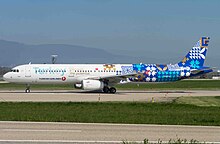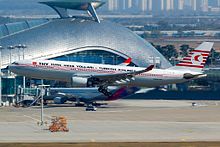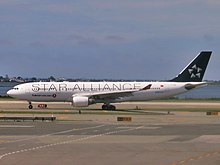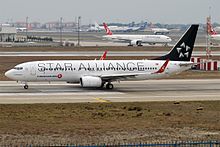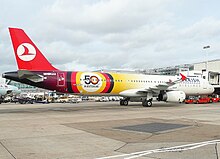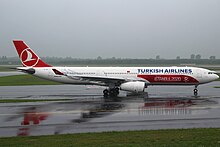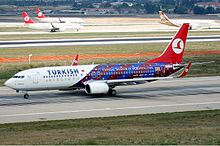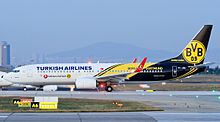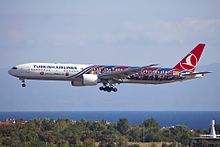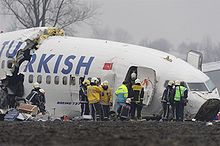Turkish Airlines
| Turkish Airlines AO | |
|---|---|

|
|
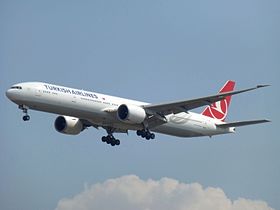
|
|
| IATA code : | TK |
| ICAO code : | THY |
| Call sign : | TURKISH |
| Founding: | 1933 |
| Seat: |
Istanbul , Turkey |
| Turnstile : | |
| Home airport : | Istanbul Airport |
| Company form: | Anonim Ortaklık |
| ISIN : | TRATHYAO91M5 |
| IATA prefix code : | 235 |
| Management: | Bilal Ekşi ( CEO ) |
| Number of employees: | 25,568 (Sept. 30, 2018) |
| Sales: | US $ 13.229 billion (2019) |
| Profit: | US $ 788 million (2019) |
| Passenger volume: | 74.28 million (2019) |
| Freight volume: | 1.54 million t (2019) |
| Alliance : | Star Alliance |
| Frequent Flyer Program : | Miles & Smiles |
| Fleet size: | 308 (+ 173 orders) |
| Aims: | National and international |
| Website: | www.turkishairlines.com |
Turkish Airlines ( Turkish: Türk Hava Yolları A. O. ) is the state-owned airline of Turkey based in Istanbul and based at Istanbul Airport . It is a member of the Star Alliance aviation alliance and a cooperation partner of the Arab Air Carriers Organization . 49.12% of the shares belong to the Turkish state, 50.88% are traded on the Istanbul Stock Exchange.
history
Propeller age
Turkish Airlines was founded on May 20, 1933 under the name Türkiye Devlet Hava Yollari (DHY) . At that time the fleet consisted of two Curtiss Kingbirds with five seats each, two Junkers F 13s with four seats each and a De Havilland DH.84 Dragon with ten seats. In 1938 Douglas DC-3 was added to the fleet . The first international flight took place in 1947 from Ankara via Istanbul to Athens . A total of seven De Havilland DH.114 Herons were added to the fleet in 1955. In 1956, DHY was renamed Türk Hava Yollari AO (THY) . Between 1958 and 1961, Vickers Viscount , Fokker F-27 and Fairchild F-27 were purchased.
The jet age
In 1967 the first jet aircraft was integrated into the airline's fleet, a Douglas DC-9-14 . In 1971 a Boeing 707 , initially leased, was added. On December 1, 1972, a McDonnell Douglas DC-10 was the first wide-body aircraft to be delivered to Turkish Airlines; she was the first non-American operator of this type of aircraft. In 1973 the F-27 were replaced by the Fokker F28 , in 1974 the first Boeing 727s were integrated into the fleet and the subsidiary Cyprus Turkish Airlines was founded. In 1983 the fleet was supplemented with aircraft of the type de Havilland Canada DHC-7 , in 1985 with the Airbus A310 . In June 1986 the first connection to the Far East was established by a flight to Singapore , in August 1988 the first flight to New York City took place. In 1987 the airline Boğaziçi Hava Taşımacılık (BHT) was founded together with investment banks . As the desired capacity utilization was not achieved, the company withdrew from the BHT freight and charter business in 1989. In 1989, Turkish Airlines founded the domestic airline Türk Hava Taşımacılık (THT) with regional BAe ATP aircraft and, together with Lufthansa, the charter airline Sunexpress .
Expansion in the 1990s
Starting in 1990, the brand's outward appearance was gradually changed from the so far leading Türk Hava Yollari (THY) to Turkish Airlines . In 1991, Turkish Airlines began expanding its fleet with Boeing 737 aircraft . In June 1993 the first Airbus A340-300s were integrated into the fleet. In the same year, smaller machines of the type Avro RJ100 for domestic flights followed. In 1994 the third A340 was purchased and the Douglas DC-9 was retired. In 1994 it was decided to integrate the THT into the THY; the BAe ATP were returned. In 1996 Lufthansa gave its 49% stake in Sunexpress to the vacation airline Condor (later Thomas Cook). In 2007 Lufthansa bought back these shares.
In 1998 Turkish Airlines founded the Qualiflyer Group aviation alliance with six other companies . In addition to adding 15 Boeing 737-800s to the fleet (first delivery in May 1998), the second large maintenance hangar was put into operation in 1999. Turkish Airlines thus has more capacity for maintenance work for other airlines. Since 1999 there has been a smoking ban in all Turkish Airlines machines.
Development since 2000
Turkish Airlines added seven additional Boeing 737-800s and an Airbus A340 to its fleet in 2000 . The first flights to Sydney were taken on the occasion of the 2000 Summer Olympics . The frequent flyer program “ Miles & Smiles ” was also introduced in 2000.
In 2005, four new Airbus models were added to the fleet: A320 , A321 and the first A330 . Another 15 737-800s were ordered from Boeing. In the same year, the appearance and the service concept were renewed: the aircraft received a new color scheme with a tulip on the vertical tail . From 2006, Turkish Airlines concluded an agreement with Kenya Airways and negotiated joining the Star Alliance . In the same year Pratt & Whitney and Turkish Airlines Technic signed an agreement to build a large maintenance center at Istanbul Sabiha Gökçen Airport , which became P & W's eighth maintenance center in the world.
Turkish Airlines has been certified according to the quality standards OHSAS 18001: 1999, ISO 9001: 2000 and ISO 14001: 2004 since 2006 .
In 2008, Turkish Airlines founded the low-cost airline Anadolujet in the face of increasing competition for low-cost flights on domestic routes . In December 2008, 49% of the shares in the Bosnian-Herzegovinian airline B&H Airlines were taken over. The airline also expressed interest in taking over the troubled Serbian airline JAT Airways (now Air Serbia ) and Poland's national airline LOT ; these plans were later discarded. On December 24 and 25, 2008, two long-haul Boeing 777-300ER aircraft joined the fleet. With these machines a first class was also offered, u. a. to Singapore, Hong Kong, London, New York and Tokyo.
Since 1 April 2008, Turkish Airlines member of the 1997 founded airline alliance Star Alliance .
In 2010, Turkish Airlines increased its sports sponsorship as part of its marketing strategy . She became the Official Carrier or main sponsor for some football and basketball clubs such as FC Barcelona , Manchester United , Shakhtar Donetsk , Borussia Dortmund , Galatasaray Istanbul and Trabzonspor . In 2011 she became the title sponsor of the ULEB Euroleague , which is officially called "Turkish Airlines Euroleague" .

In addition to the regular economy class, a new premium economy class has also been introduced on long-haul routes, with a seat pitch of 116 cm and its own seats. In addition, it offers (according to its own information as the first airline in the world) live television on transatlantic flights .
In November 2013 Lufthansa terminated the code-sharing agreement with Turkish Airlines effective March 31, 2014. The reason for this is the increasing competition between the two airlines.
In 2013, the airline had $ 9,826 million in revenue, 11,070 million in 2014 and 10,522 million in 2015.
In 2015, the head of the board of directors and some board members were replaced by managers close to the ruling AKP party. In the first quarter of 2016, Turkish Airlines posted a loss of a good 500 million US dollars with a turnover of 2.2 billion US dollars. A war of direction between veteran managers and executives posted by the AKP grew stronger. The number of German visitors to Turkey fell by 30 percent in the first quarter of 2016.
Developments after the attempted coup in 2016
After the failed coup attempt in Turkey on July 15, 2016, the Turkish economy suffered a severe shock. Turkish Airlines' share price fell. Due to security concerns after the terrorist attack at Istanbul Airport on June 28, 2016 and after the attempted coup, the FAA banned the airline from flights to the United States until August 15, 2016. A little later the FAA lifted this flight ban; Since July 19, 2016, the airline has been able to fly to America again. In the days after the coup, 211 employees, allegedly supporters of the Gülen movement , were laid off. Turkish government agencies describe Fethullah Gülen as the mastermind behind the coup.
In August 2016, Turkish Airlines announced a loss of 198 million euros for the second quarter . For 2016, ten million fewer passengers than planned were expected. Shortly before, the company had already announced extensive cuts in the route network, for example frequencies to 45 European and 13 intercontinental routes were cut for the next flight planning period and around a dozen other routes were reduced from year-round to seasonal service, including three destinations in Germany ( Friedrichshafen , Münster / Osnabrück and Karlsruhe / Baden-Baden ).
In the summer of 2017, Turkish Airlines reversed many of its changes to the flight schedule and even offered new flights. Several German and French airports now served direct flights to Izmir. Domestic and international airports have been added to the route network from Istanbul. In the third quarter, the airline posted record profits and signed a letter of intent for the Boeing 787. So Turkish Airlines got back in 2017 after suffering a shock over the political unrest in 2016.
In March 2018, Turkish Airlines converted its letters of intent for the Boeing 787 and Airbus A350 into orders. A new sales record was reported at the end of the year.
New airport in Istanbul
The New Istanbul Airport opened on October 29, 2018 with trial operations. All airlines that have flown to Ataturk Airport are taking off from the new airport today. The biggest customer at the new Istanbul airport is Turkish Airlines. Before the move to the new base, the Chairman of the Board of Directors İlker Aycı had announced that his company wanted to dress up for the move in order to present some innovations at the time of the opening of the new airport. The employees got new uniforms, which have been worn since August 9, 2019. Turkish Airlines worked with the Italian fashion designer Ettore Bilotta for this. The Turkish airline also has its own check-in counters, terminals and hangars at the new Istanbul Airport. On October 23, 2018, Turkish Airlines decided that the catering on the aircraft, as well as in the lounges, would be handed over to DO&CO for the next 15 years .
The date for the move has been postponed four times. The move then started on April 5, 2019. However, after opening, Turkish Airlines already had four Boeing 737-800s and two Airbus A320-200s and one Airbus A321-200 stationed at the new airport and offered 15 flights a day. The first destinations were Adana, Ankara, Antalya, Gaziantep, Hatay, Izmir and Trabzon domestically and Amman, Ashgabat, Baku, Frankfurt, Kuwait City, Lefkoşa, London, Munich, Paris and Tbilisi abroad. With the move, Istanbul Ataturk Airport was closed to scheduled flights.
Destinations
Turkish Airlines offers Istanbul destinations in North and South America , Africa , Europe and the Middle and Far East . Anadolujet and Sunexpress also operate routes . Turkish Airlines is also the airline that flies to the most destinations worldwide with 52 national and 267 international destinations.
In German-speaking countries are in Germany Berlin Tegel Bremen , Dusseldorf , Frankfurt , Friedrichshafen , Hamburg , Hannover , Karlsruhe / Baden-Baden , Cologne / Bonn , Leipzig / Halle , Munich , Nuremberg and Stuttgart fly.
In Austria , Graz , Salzburg and Vienna are destinations.
In Switzerland , Turkish Airlines flies to Basel , Geneva and Zurich .
Code sharing
Turkish Airlines has codeshare agreements with the following airlines: ( Star Alliance members are marked with * )
- Air Astana
- Air Canada *
- Air China *
- Air India *
- Air Kyrgyzstan
- Air New Zealand *
- Air Malta
- All Nippon Airways *
- Asiana Airlines *
- Avianca *
- Croatia Airlines *
- Egypt Air *
- Aegean Airlines *
- Ethiopian Airlines *
- Etihad Airways
- Garuda Indonesia
- Iran Air
- jetBlue
- Kuwait Airways
- Loganair
- Luxair
- Malaysia Airlines
- PIA
- Oman Air
- LOT *
- Royal Air Maroc
- RwandAir
- UIA
- SAS *
- Singapore Airlines *
- TAP Portugal *
- Thai Airways *
- United Airlines *
- UTair
fleet
Current fleet
As of July 2020, the Turkish Airlines fleet consists of 308 aircraft with an average age of 7.1 years:
Scheduled flight operations
| Aircraft type | number | ordered | Remarks | Seats ( Business / Eco ) |
Average age
(July 2020) |
|---|---|---|---|---|---|
| Airbus A319-100 | 6th | 132 (12/120) | 9.2 years | ||
| Airbus A320-200 | 13 | 1 with Sharklets equipped | 159 (12/147) 162 (12/150) |
12.5 years | |
| Airbus A321-200 | 66 | 34 equipped with sharklets | 178 (20/158) 180 (16/164) 194 (12/184) |
7.9 years | |
| Airbus A321neo | 19th | 71 | first delivery on July 13, 2018 (TC-LSA) ; Delivery by 2023 | 182 (20/162) | 0.9 years |
| Airbus A330-200 | 13 | 220 (30/190) 250 (18/232) 269 (18/251) 279 (24/255) |
10.0 years | ||
| Airbus A330-200F | 10 | Cargo planes ; operated under the Turkish Cargo brand | - | ||
| Airbus A330-300 | 40 | 1 leased from Afriqiyah Airways | 289 (28/261) 291 (28/263) 305 (40/265) 337 (27/310) 345 (27/318) |
6.6 years | |
| Airbus A350-900 | 25th | + 5 options; Delivery 2020-2023 | 329 (32/297) | ||
| Boeing 737-800 | 62 | equipped with winglets ; another 40 B737-800 are sold under the brand AnadoluJet operated | 151 (16/135) 165 (12/153) |
9.0 years | |
| Boeing 737-900ER | 15th | 151 (16/135) 169 (16/153) |
7.3 years | ||
| Boeing 737 MAX 8 | 11 | 54 | first delivery on August 17, 2018; Delivery by 2022; all inactive | 151 (16/135) | 1.7 years |
| Boeing 737 MAX 9 | 1 | 9 | first delivery on March 1, 2019; Delivery by 2020; inactive | 169 (16/153) | 1.5 years |
| Boeing 777F | 8th | Cargo planes; operated under the Turkish Cargo brand | 1.5 years | ||
| Boeing 777-300ER | 33 | 3 leased from Kenya Airways | 349 (49/300) 400 (28/372) |
6.7 years | |
| Boeing 787-9 | 11 | 14th | + 5 options; first delivery on June 25, 2019 (TC-LLA) ; Delivery by 2022 | 300 (30/270) | 0.8 years |
| total | 308 | 173 | 7.1 years |
Government aircraft
Turkish Airlines operates seven aircraft for the Turkish government, with an average age of 10.8 years (as of November 2018):
| Aircraft type | Aircraft registration | Remarks |
|---|---|---|
| Airbus ACJ318 | TC-ANK | |
| Airbus ACJ319 | TC-ANA | |
| TC-IS | ||
| Airbus ACJ330 | TC-TUR | |
| Airbus A340-500 | TC-CAN | |
| Boeing 747-8 | TC-TRK | |
| Canadair CL-600-2B19 Challenger 850 | TC-TRY |
Training aircraft
Turkish Airlines trains its pilots on two Cessna Citation Mustangs, among other things .
Previously deployed aircraft
In the past, Turkish Airlines operated, among others, the following types of aircraft:
- Airbus A300B4-200 (FF)
- Airbus A310 -200/300
- Airbus A340-300
- Avro RJ70 / RJ100
- Boeing 707
- Boeing 727-200
- Boeing 737-400/500/700
- Curtiss Kingbird
- De Havilland Canada DHC-7
- De Havilland DH.84 Dragon
- De Havilland DH.114 Heron
- Douglas DC-3
- Douglas DC-9 -10/30
- McDonnell Douglas DC-10 -10/30
- McDonnell Douglas MD-83
- McDonnell Douglas MD-90
- Fairchild F-27
- Fokker F-27
- Junkers F 13
- Vickers Viscount
Fleet policy
All Turkish Airlines aircraft are traditionally named after Turkish cities. The following principle applies here: Large models such as B. Airbus A330 / A340 are sponsored by major cities. The smaller the aircraft type, the smaller the eponymous city. Due to the expansion of the fleet, the number of aircraft exceeded that of the 81 Turkish provinces, which means that the aircraft are also named after known locations and terms.
From June 2008 to December 2008, the number of aircraft rose from 105 to 120. During this time, the number of travel destinations was to be continuously increased through orders and, thanks to lower kerosene consumption, flown more economically. Turkish Airlines also intended to increase its share of long-haul flights by adding flights to North and South America, Australia and the Far East.
In October 2010 she received her first own Boeing 777-300ER with the aircraft registration TC-JJE . It got a new livery under the name Dolmabahce . With this new type of aircraft, Comfort Class was introduced for the first time. As a premium economy, it is located between economy and business class.
In March 2013, the largest order to date was confirmed with Airbus, with which Turkish Airlines wanted to achieve a fleet of 375 aircraft. At Airbus 117 aircraft were ordered. In addition, 20 A330-300s and three A330-200Fs were ordered. 13 737-800s, five 737-900ERs and 20 777-300ERs were ordered from Boeing. On May 14, 2013, Turkish Airlines placed an order for 50 Boeing 737 MAXs and another 20 737-800s. Another 25 Boeing 737 MAXs were ordered as options, ten of which were redeemed. Turkish Airlines thus had a total of 95 orders open with Boeing.
In 2013 and 2014, a total of 15 A321neo options were converted into firm orders and four A320neo orders into an equal number of A321neo orders. In addition to the 53 firmly ordered A321neo, 19 more firm orders were added.
In September 2017, Turkish Airlines signed a letter of intent to purchase 40 Boeing 787-9s . On January 5, 2018, a letter of intent to purchase 20 (+5 options) Airbus A350s was signed. In March 2018, 25 Airbus A350-900 (+5 options) and Boeing 787-9 were firmly ordered.
Special paints
Belonging to the Star Alliance is expressed with one aircraft of each type with a special paint on the tail fin, which is what all partners of the alliance do. Turkish Airlines uses additional colors to indicate special occasions, such as airline anniversaries, new destinations, sporting events or other events. In addition, some special paint schemes are part of sponsorship deals.
Many special paints are only used temporarily and are later repainted in the standard colors.
- Current special paints
| Aircraft type | Aircraft registration | Remarks | image |
|---|---|---|---|
| Airbus A319-100 | TC-JLU | " Star Alliance " | |
| Airbus A320-200 |
TC-JPF TC-JPP TC-JPS |
||
| Airbus A321-200 |
TC-JRA TC-JRB TC-JRL TC-JRP |
||
| TC-JRG | "Turkey - Discover the potential" | ||
| TC-JRO | " EuroLeague " | ||
| TC-JTP | " The Year of Troy " | ||
| Airbus A330-200 | TC-JIZ | "Invest in Turkey" | |
| TC-JNC | " Retro " | ||
| TC-LNB | "Star Alliance" | ||
| Boeing 737-800 |
TC-JHC TC-JHE |
- Former special paints
| Aircraft type | Aircraft registration | Remarks | image |
|---|---|---|---|
| Airbus A320-200 | TC-JLC | " Retro painting of the 1970s " | |
| Airbus A321-200 | TC-JRK | "50 years in Germany" | |
| Airbus A330-300 | TC-JNI | " Istanbul 2020 " | |
| TC-JOH | " European Football Championship 2016 " | ||
| Airbus A340-300 | TC-JII | " 2002 World Cup Finalist " | - |
| Boeing 737-800 | TC-JFV | " Manchester United " | |
| TC-JGU | "100th Aircraft" | ||
| TC-JGY | FC Barcelona | ||
| TC-JHF | " Basketball World Cup 2010 " | ||
| TC-JHL | "Globally Yours" | ||
| TC-JHU | " Borussia Dortmund " | ||
| Boeing 737-900ER | TC-JYI | "200th Aircraft" | |
| TC-JYP | " Turkey National Football Team " | ||
| Boeing 777-300ER | TC-JJI | "FC Barcelona" | |
| TC-JJU | " Istanbul-San Francisco " | - | |
| TC-YJN | " Batman v Superman: Dawn of Justice " |
service
Cabin product
The Turkish Airlines service is divided into a system of two classes of transport, business class and economy class. The airline abolished Premium Economy Class in 2016 due to a lack of demand.
Business class
There are currently two business classes on long-haul routes. A 1-2-1 configuration will be installed in the newer long-haul aircraft (Boeing 787 and, in the future, Airbus A350). The seat spacing is 111 cm. The seats can be converted into flat, 193 cm long reclining surfaces. The older business class will be installed in a 2-3-2 configuration in the Boeing 777 and in a 2-2-2 configuration in the Airbus A330 aircraft. These seats can also be converted into flat lying areas that are 196 cm long. The catering consists of several meals that the passenger can put together.
2-2 seating is used on the short-haul routes operated by Turkish Airlines. The airline still uses the principle of the "class dividers" in a few older aircraft (the middle seat then remains free). The seats on the short haul differ in width and seat spacing from those in Economy Class. This business class is located in the Boeing 737 and Airbus A320.
Economy class
The economy class cabin presented in 2018 will be installed in all Boeing 737 and Airbus A321s over the next three years. Each seat has a screen with an in-flight entertainment system. On domestic flights you get warm sandwiches and drinks, on international flights a warm meal with Turkish tea or Turkish coffee afterwards with dessert.
In the long-haul aircraft there is a "snack bar", a small counter from which passengers can get drinks and snacks between meals.
Lounges
Turkish Airlines operates its own lounges at Bangkok-Suvarnabhumi , Istanbul , Moscow-Wnukowo , Nairobi , Washington-Dulles , and other airports in Turkey. A distinction is made between three lounges. The Business Lounge is intended for business class passengers and passengers with Star Alliance Gold status and is available at six different airports around the world. Miles & Smiles passengers with the status Elite Plus, Elite or Classic Plus at Istanbul Airport have access to the Miles & Smiles lounge . Business Class, Miles & Smiles members and passengers with Star Alliance Gold status can also use the Domestic lounge, which is offered at most Turkish airports. Cooks prepare dishes in the lounges. There are several conference rooms in the lounge. Suites are available for travelers with a longer stopover. Travelers have their own check-in and security facilities, as well as passport controls. You can then get to the aircraft by CIP bus.
Awards
- 2009:
- Skytrax Awards: Best Southern European Airline
- 2010:
- Skytrax Awards: Best Airline in Southern Europe. Best onboard catering in economy class
- 2011:
- Skytrax Awards: Best Airline in Europe and in Southern Europe. Airline
- Market Leadership Award 2011
- 2012:
- Skytrax Awards: Best Airline Europe, Best Southern European Airline, Best Seats in Premium Economy Class
- 2013:
- Air Transport Awards: Airline of the Year
- Skytrax Awards: Best Airline in Europe, Best Catering in Business Class, Best Airline in Southern Europe
- CAPA: Airline of the Year Award 2013
- 2014:
- Cargo Airline of the Year Awards: Best European Cargo Airline
- Skytrax Awards: Best Airline in Europe and in Southern Europe. Best business class onboard catering. Best Business Class Lounge Dining.
- 2015:
- Skytrax Awards: Best Airline in Europe and in Southern Europe. Best business class airline catering. Best Business Class Lounge Dining.
- 2016
- Skytrax Awards: Best Airline in Europe and in Southern Europe. Best business class airline catering. Best Business Class Lounge Dining.
- 2017:
- Skytrax Awards: Best Airline Business Class Lounge. Best business class catering. Best Business Class Lounge Dining. Best airline in southern Europe.
- 2019:
- APEX Awards: 5-star airline of the year 2020
In June 2018, Turkish Airlines announced that they would no longer participate in the Skytrax Awards. From that point on, only reviews based on passengers' direct experience will be considered, the airline said. With the opening of “Istanbul Airport”, the flight experience for passengers will be further improved.
In the Skytrax rating of 2018, which lets air travelers choose the best airlines in the world, Turkish Airlines slipped from 12th to 18th place. In May 2019, Skytrax downgraded Turkish Airlines as a 3-star airline, which is why they are now working with low-cost airlines How Easyjet and Ryanair can be compared, even though Turkish Airlines officially stopped participating in 2018. However, this assessment has been criticized. The arguments were that Lufthansa performed better in comparison in almost all categories and that such clear quality differences, as stated by Skytrax, could not be ascertained.
Subsidiaries / Business Units
SunExpress
After it a strong demand for direct flights from the DA-CH had noted countries to Antalya and Izmir, the company was founded in 1989 as a joint venture of Lufthansa and Turkish Airlines initially with a Boeing 737-300 founded and 64 employees. Sunexpress is a charter airline that today flies to many European destinations with Turkey and other Mediterranean destinations.
AnadoluJet
The AnadoluJet division was set up by Turkish Airlines as a virtual airline in February 2008 . It took over all the national routes of Turkish Airlines from Ankara and Istanbul Sabiha Gökçen. In return, Turkish Airlines had stopped all domestic flights from these two airports. AnadoluJet is a low cost airline. Since it is not a real airline, it has to use the Air Operator Certificate from Turkish Airlines. AnadoluJet and Turkish Cargo are expected to become independent airlines in the foreseeable future.
Turkish Cargo
In 1969 Turkish Cargo received its first freighter, a Fairchild F-27. In the following years, more aircraft joined the fleet. Strong growth began in 2010. In 2018 the cargo division grew by 19.4%. Turkish Airlines aims to be among the five largest cargo airlines in 2023. They want to achieve this with Istanbul Airport and new planes. Two cargo terminals are currently being built at Istanbul Airport . The smaller building will be erected on an area of 25,000 m² and is intended for goods that need to be cooled. The larger terminal will be built on an area of 165,000 m². The “Mega Cargo Facility” (both facilities together) will have an annual capacity of four million tons of freight. Until the completion of the terminal at Istanbul Airport, Turkish Cargo mainly flew from Ataturk Airport.
Turkish Cargo operates a total of 23 cargo planes, eight of which are operated in wet lease for Turkish Cargo. Turkish Cargo also benefits from the strong network of Turkish Airlines. There are direct connections with cargo planes to 86 destinations (as of February 2019); in addition, it markets the cargo capacities of the more than 300 passenger aircraft (so-called belly capacities) of Turkish Airlines and AnadoluJet for the remaining 300 destinations .
Turkish Airlines' chief cargo officer is Turhan Özen.
Air Albania
After Albanian Airlines ceased operations in 2011, talks with various airlines regarding the establishment of a new Albanian flag carrier began. In July 2018, the preparations were so advanced that Turkish Airlines leased one of their Airbus A319s to Air Albania . The aircraft was repainted, but still has a Turkish registration. The cabin has also been redesigned. In the future, the fleet will then consist of the Airbus A319 and an additional Airbus A320. For the time being, Air Albania will fly to Istanbul and cities in the Balkans. Western European destinations are to follow later. 51% of the shares belong to Albanian companies, 49% to Turkish Airlines.
Turkish Technic
In 2006 aircraft maintenance was transferred to the newly founded Turkish Technic . It operates nine hangars in Turkey, as well as the HABOM complex at Istanbul Sabiha-Gökçen Airport. Today it is one of the leading providers of MRO services in the Middle East.
Turkish DO&CO
In 2007, the Turkish Do & Co joint venture with the Austrian Do & Co was founded. The catering company based in Istanbul prepares hot meals, sandwiches and drinks at nine locations in Turkey for Turkish Airlines and 60 other customers. It is used for the flights and also for the lounges of Turkish Airlines.
TGS (Turkish Ground Services)
Founded in August 2008, TGS is responsible for the ground handling of Turkish Airlines aircraft at all Turkish airports. It is a joint venture with the ground handling company Havaş.
Incidents
Between 1950 and 1956, Turkish Airlines (as Devlet Hava Yollari - DHY) lost five aircraft, killing a total of 54 people.
Thereafter, 16 aircraft were lost under the name of Türk Hava Yollari by 1990, killing a total of 754 people.
The company then lost another ten aircraft by November 2017, with a total of 187 fatalities.
Aviation accidents
(Extracts)
- On March 25, 1950, from crashed Istanbul next Douglas DC-3 / C-47A-75-DL Türkiye Devlet Hava Yollari (DHY) ( air vehicle registration TC-BAL ) while landing at the airport Ankara Etimesgut and caught fire. All 15 occupants were killed, 4 crew members and 11 passengers.
- On November 19, 1951, a Douglas DC-3 / C-53-DO of Devlet Hava Yollari (DHY) (TC-ACA) coming from Ankara was flown into a sand dune while approaching Cairo International Airport . In this CFIT, Controlled flight into terrain , all 5 occupants were killed.
- On April 3, 1954, a Douglas DC-3 / C-47A-80-DL of the Devlet Hava Yollari (DHY) (TC-ARK) launched from Adana Airport to Istanbul crashed 15 minutes after take-off. All 25 occupants were killed, 5 crew members and 20 passengers.
- On February 17, 1959, a Vickers 794D Viscount of the Türk Hava Yollari - THY (TC-SEV) was flown into the ground while approaching London-Gatwick Airport (CFIT, Controlled flight into terrain ). The machine coming from Rome fell below the glide path of the instrument landing system and collided with trees 5.2 kilometers west of the airport and caught fire. Of the 24 people on board, 14 were killed.
- On September 23, 1961 a Fokker F-27-100 of the Türk Hava Yollari - THY (TC-TAY) was flown into a mountain 18 kilometers from the destination airport Ankara-Esenboğa . In this CFIT, controlled flight into terrain , 28 of the 29 occupants were killed, all 4 crew members and 24 passengers.
- On January 20, 1968, the nose landing gear of a Douglas DC-7B operated by Transair Sweden (SE-ERC) collapsed during landing at Munich-Riem Airport . The machine leased to Türk Hava Yollari (THY) came off the runway. All 38 occupants (6 crew members and 32 passengers) were uninjured. The aircraft was damaged beyond repair.
- On February 2, 1969, the Türk Hava Yollari - THY (TC-SET) was approached too low with a Viscount 794D on its approach to Ankara-Esenboğa airport ; it collided with a power pole, fell and caught fire. All 26 occupants survived the accident.
- On January 21, 1972, a had to Douglas DC-9-32 of Turk Hava Yollari (TC-JAC) on a flight from Ankara Airport to Damascus airport due to problems with the cabin pressure on the Adana airport emergency landing. The machine crashed on the second approach. There were no passengers on board. Of the five crew members, one person was killed.
- On January 26, 1974, when a Fokker F28 Fellowship 1000 from Türk Hava Yollari (TC-JAO) started at Izmir Airport , a serious accident occurred. There was a stall at a height of eight to ten meters , the machine suddenly turned to the left and crashed 100 meters from the runway. 66 of the 73 inmates were killed. The plane was supposed to fly to İstanbul-Ataturk. The causes of the accident were excessive rotation (lifting of the nose) and hoar frost on the wings (see also Turkish Airlines flight 301 ) .
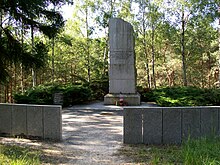
- On March 3, 1974, the most devastating accident in the history of Turkish Airlines occurred when all 333 passengers and the 13 crew members on board a fully occupied McDonnell Douglas DC-10 (TC-JAV) perished in the crash immediately after take-off from Paris-Orly Life came. The cause was the improper locking of the rear cargo hatch on the ground, which was prone to such problems due to the design (see also Turkish Airlines flight 981 ) .
- On January 30, 1975, the pilots of a Fokker F28 Fellowship 1000 from Türk Hava Yollari (TC-JAP) coming from Izmir had to abort their landing approach because the runway lights at Istanbul-Yesilköy airport had failed due to an electrical fault . After it has been re-activated via the emergency power supply and the crew asked permission to land, air traffic control had this view of the imminent start of a Boeing 707 of Pan Am on to fly an extended hold.
- When the air traffic controllers tried to contact the machine ten minutes later, they received no answer because the pilots had flown the machine 30 kilometers west into the water (CFIT, Controlled flight into terrain ). The remains of the occupied with 38 passengers and four crew members were machine only seven years later on the basis of the Marmara Sea located (see Turkish Airlines Flight 345 ) .
- On September 19, 1976, a Boeing 727-200 flew into the slope of a mountain near Karatepe on the flight from Istanbul to Antalya. The accident occurred as a result of a pilot's error during the approach. All 154 people, including 146 passengers and 8 crew members, were killed in the crash (see also Turkish Airlines flight 452 ) .
- On December 23, 1979, a Fokker F28-1000 (TC-JAT) of the Türk Hava Yollari was flown on the way from Samsun Airport to Ankara with a total of 41 passengers and 4 crew members on board, approaching a hill, 32 kilometers north of the destination airport Ankara-Esenboğa near Kuyumcuköy. The approach was supposed to be performed using the instrument landing system, but the aircraft deviated from the approach route and was destroyed in the process. Of the total of 45 occupants, 41 were killed, including three of the four crew members and 38 of the 41 passengers.
- On 16 January 1983, a continued Boeing 727-2F2 the Turk Hava Yollari (TC-JBR) on the flight from Istanbul-Yesilköy for Ankara Airport 50 meters before the runway, broke apart and caught fire. The seven-member crew survived, 47 of the 60 passengers were killed (see also Turkish Airlines flight 158 ) .
- On December 29, 1994, a Boeing 737-400 coming from Ankara crashed while approaching Ferit Melen Airport in Van . The machine crashed into a mountain at an altitude of around 1700 meters in poor visibility and a snowstorm . Five of the seven crew members and 52 of the 69 passengers were killed in the accident (see also Turkish Airlines flight 278 ) .
- On April 7, 1999, a Boeing 737-400 crashed in bad weather near Ceyhan while climbing. Why the pilots lost control of the aircraft is unknown. The 737 was on a transfer flight, there were no passengers on board. All six crew members were killed (see also Turkish Airlines flight 5904 ) .
- On January 8, 2003, an Avro RJ100 crashed on final approach near Diyarbakir Airport (Turkey). When flying through a fog bank, the pilots lost their orientation and touched down in front of the runway. The plane broke into several parts and started to burn. Only five people survived, 75 people were killed (see also Turkish Airlines flight 634 ) .
- On February 25, 2009, a Boeing 737-800 crashed on its final approach to Amsterdam on a field near a settlement in front of Amsterdam Airport Schiphol and broke apart. Of the 128 passengers and seven crew members on board, nine people were killed, including all three pilots. In the final investigation report, the Dutch flight safety authority sees the cause in a defect in the radar altimeter to which the crew reacted incorrectly (see also Turkish Airlines flight 1951 ) .
- On October 31, 2010 an Airbus A310-304F of Turkish Airlines Cargo (TC-JCV) came off the runway to the left when landing at Casablanca Airport . The pilots managed to steer the machine back onto the runway, but one of the engines had been damaged by earth. The 22 year and 9 month old machine was written off as a total economic loss due to the incident.
- On March 4, 2015, an Airbus A330-300 operated by Turkish Airlines landed next to the runway at Kathmandu Airport . None of the 224 passengers and crew members were injured. Since there is a lack of appropriate evacuation equipment in Nepal and this had to be brought from India , the airport of Kathmandu was closed for 72 hours. The aircraft had to be written off and was converted into a museum in 2017.
- On April 25, 2015, an Airbus A320-200 of Turkish Airlines (TC-JPE) coming from Milan hit runway 05 of Istanbul-Ataturk Airport very hard and hit the ground with the right engine. The pilots decided to take off and then land on the 400 meter longer 17L / 35R runway. The airport was closed after the pilots made a distress call because they had problems with the right engine. When the damaged right landing gear collapsed on landing, the aircraft turned almost 180 ° to the right and then came to a standstill. All 97 passengers and the crew survived the crash landing. The aircraft was damaged beyond repair.
- On January 16, 2017, a Boeing 747-412F crashed into a residential area while approaching Manas Airport in Bishkek ( Kyrgyzstan ). All four crew members and 35 residents were killed. The aircraft was operated by ACT Airlines and had been chartered by Turkish Airlines (see also Turkish Airlines flight 6491 ) .
Other incidents
- The penultimate aircraft hijacked was on October 3, 2006, when an unarmed passenger forced a Boeing 737-400 on Turkish Airlines Flight 1476 from Tirana to Istanbul to land in Brindisi . After landing, the kidnapper sought political asylum.
- The last attempted aircraft hijacking occurred on January 5, 2011, when a 40-year-old man tried to hijack a Boeing 737-800 on Turkish Airlines Flight 1754 from Oslo to Istanbul. However, other passengers managed to overpower the man and he was arrested after landing.
See also
Web links
- Turkish Airlines website (Turkish, English)
- Turkish Airlines website (German)
Individual evidence
- ↑ a b c Ankara will become a third Turkish Airlines hub . Air Transport World. August 21, 2015. Accessed June 29, 2018.
- ^ Board of Directors. In: investor.turkishairlines.com. Turkish Airlines, accessed January 17, 2017 .
- ↑ a b investor.turkishairlines Board's Activity Report 3Q '18 (English), accessed on February 18, 2019.
- ↑ a b TÜRK HAVA YOLLARI ANONİM ORTAKLIĞI AND ITS SUBSIDIARIES. Retrieved June 3, 2020 .
- ↑ a b Traffic Data - January-December 2018
- ^ Turkish Airlines joins Star Alliance. In: staralliance.com. Star Alliance Services GmbH, April 1, 2008, accessed on March 19, 2013 (English).
- ↑ Turkish Airlines joins Arab Air Carriers Organization. In: aero.de. July 4, 2011, accessed March 19, 2013 .
- ↑ TÜRK HAVA YOLLARI ANONİM ORTAKLIĞI AND ITS SUBSIDIARIES. (PDF; 275 kB) CONDENSED CONSOLIDATED FINANCIAL STATEMENTS FOR THE NINE-MONTH INTERIM PERIOD ENDED 30 SEPTEMBER 2012. In: turkishairlines.com. Turkish Airlines, September 2012, p. 7 , archived from the original on October 15, 2013 ; accessed on November 28, 2017 (English).
- ↑ Boeing - First Boeing 737-800 for Turkish Airlines in Final Assembly ( Memento from January 12, 2012 in the Internet Archive ) (English), accessed on May 26, 1998
- ↑ Turkish Airlines Adds Next-Generation 737-800s to Its Fleet ( Memento from January 12, 2012 in the Internet Archive ), accessed on September 29, 2004
- ↑ turkishairlines.com - The Success Of Turkish Airlines In Flight Safety Confirmed Once Again ( Memento August 5, 2011 in the Internet Archive ), accessed on October 19, 2010
- ↑ Turkey Financial News - Turkish Airlines buys 49 percent of Bosnian company ( Memento of July 13, 2010 in the Internet Archive ) (English), accessed on December 23, 2008
- ↑ Turkish Airlines extends its feelers to Eastern Europe. Handelsblatt, May 17, 2010, accessed on July 3, 2011 .
- ↑ airliners.de - Weekly Review: From all over the world , accessed on June 8, 2012
- ↑ thy.com - Türk Hava Yolları'nda “First Class” hizmeti… ( Memento from April 29, 2009 in the Internet Archive ) (Turkish), accessed on December 25, 2008
- ^ Turkish Airlines sign strategic partnership deal. euroleague.net, July 26, 2010, accessed July 3, 2011 .
- ↑ Michael Machatschke: Please buckle up! In: Manager magazine . No. 5 , 2014, p. 36-43 .
- ↑ FlugRevue July 2011, pp. 22–27, transfer with Turkish
- ^ Westdeutsche Zeitung: For the first time live television on transatlantic flights. Retrieved January 21, 2019 .
- ↑ Jens Flottau: Divorce in Turkish . In: sueddeutsche.de . November 26, 2013, ISSN 0174-4917 ( sueddeutsche.de [accessed January 21, 2019]).
- ↑ Turkish Airlines - Revenue up to 2017 | Statistics. Retrieved January 21, 2019 .
- ↑ a b wiwo.de July 12, 2016: What the airline is struggling with
- ^ Ulrich Friese: Air traffic: America bans Turkish Airlines from flying . In: Frankfurter Allgemeine Zeitung . July 18, 2016, ISSN 0174-4909 ( faz.net [accessed July 18, 2016]).
- ↑ aerotelegraph.com - USA ban hits Turkish Airlines hard , accessed on July 18, 2016
- ↑ aerotelegraph.com - Wave of purges reaches Turkish Airlines , accessed on July 25, 2016
- ↑ Frankfurter Rundschau - massive drop in profits at Turkish Airlines , accessed on August 20, 2016
- ↑ routesonline.com - Turkish Airlines W16 Europe / Short-Haul service changes as of 27AUG16 , accessed on August 27, 2016
- ↑ routesonline.com - Turkish Airlines W16 inter-continental service changes as of 27AUG16 (English), accessed on August 27, 2016
- ↑ TRAVEL INSIDE: Turkish Airlines with best third quarter in history - TRAVEL INSIDE . In: aboutTravel . November 13, 2017 ( abouttravel.ch [accessed March 10, 2018]).
- ↑ Boeing 787-9: Turkish Airlines buys 40 Dreamliners | aeroTELEGRAPH . In: aeroTELEGRAPH . September 22, 2017 ( aerotelegraph.com [accessed March 10, 2018]).
- ↑ Turkish Airlines wants 30 Airbus A350-900s and 30 Boeing 787-9s . In: aero.de . March 9, 2018 ( aero.de [accessed March 10, 2018]).
- ↑ https://investor.turkishairlines.com/documents/ThyInvestorRelations/THY__FRAE__2018_ENG_v2.pdf
- ↑ İşte Türk Hava Yolları'nı bekleyen yenilikler! In: haberturk.com. Retrieved April 8, 2018 (Turkish).
- ↑ Do & Co extends cooperation with Turkish Airlines by 15 years . In: Tiroler Tageszeitung Online . October 23, 2018 ( tt.com [accessed October 23, 2018]).
- ^ Profi Reisen Verlagsgesellschaft mbH: New uniforms for Turkish Airlines employees. August 9, 2019, accessed August 14, 2019 .
- ↑ Soon the first tickets for flights from the new mega airport in Istanbul . October 10, 2018 ( cash.ch [accessed October 15, 2018]).
- ↑ THY İstanbul Havalimanı'ndan Trabzon'a İlk Tarifeli Seferini Gerçekleştirdi. Retrieved December 10, 2018 .
- ↑ Departure | Istanbul Airport. Retrieved February 25, 2019 .
- ^ Flight Network. (PDF) Turkish Airlines, September 23, 2019, accessed September 27, 2019 .
- ↑ 300. Turkish Airlines' flight destination is Phuket . In: OTS.at . ( ots.at [accessed on April 21, 2018]).
- ↑ Turkish Airlines with record profit . In: aero.de . November 10, 2018 ( aero.de [accessed November 10, 2018]).
- ↑ Codeshare (Partner) Flights , accessed September 27, 2019
- ↑ BTN News: Loganair and Turkish Airlines ink code-share agreement. MICEBTN (magazine), August 30, 2018, accessed September 27, 2019 .
- ↑ a b c d e Turkish Airlines Fleet Details and History. In: planespotters.net. May 17, 2020, accessed on July 18, 2020 .
- ↑ Airbus - Orders & deliveries (English), accessed on July 15, 2018.
- ↑ Boeing - Orders and Deliveries , accessed December 21, 2018.
- ↑ Boeing - Turkish Airlines Finalizes Order for 50 737 MAXs and 20 Next-Generation 737s, May 14, 2013 (English), accessed on May 12, 2015.
- ↑ ATWOnline - Turkish Airlines firms options on 10 737 MAX 8s, 20 A321neos, December 1, 2015 (English), accessed on January 19, 2017.
- ↑ a b Daily Sabah - After crash in Ethiopia: Turkish Airlines puts Boeing 737 MAX aircraft out of service, March 13, 2019 , accessed on March 13, 2019.
- ↑ planespotters.net - Turkey Government , accessed November 24, 2018.
- ↑ Cessna Citation Mustang Light Business Jet. In: Aerospace Technology. Retrieved on August 2, 2018 (English): "The Turkish Airlines Flight Training Academy ordered two Mustang business jets in May 2010."
- ↑ tumgazeteler.com - THY, uçak isimleri için Kültür Bakanlığı'ndan destek istedi ( Memento from January 17, 2012 in the Internet Archive ) (Turkish)
- ^ Report of the Board of Management of Turkish Airlines in autumn 2008, p. 18 ( Memento of April 3, 2012 in the Internet Archive )
- ↑ Handelsblatt - After a jump in profits: Turkish Airlines orders 117 jets from Airbus
- ↑ austrianwings.info - Turkish buys up to 95 Boeing 737s
- ↑ austrianwings.info - Turkish buys another A321
- ↑ airliners.de - Turkish Airlines wants to order Boeing Dreamliner , accessed on September 25, 2017
- ↑ Interest in 25 planes: Airbus A350 becomes concrete at Turkish Airlines In: aerotelegraph.com , accessed on January 8, 2018.
- ↑ Firm order: Turkish Airlines buys 25 A350s and 25 Dreamliners | aeroTELEGRAPH . In: aeroTELEGRAPH . March 9, 2018 ( aerotelegraph.com [accessed March 9, 2018]).
- ↑ Against the trend: Turkish is abolishing premium economy again. In: aeroTELEGRAPH. May 27, 2016, accessed February 9, 2019 .
- ^ Turkish Airlines website. Retrieved September 27, 2019 .
- ↑ Boeing 787. Retrieved September 27, 2019 .
- ↑ Review: Turkish Airlines A321 Business Class. March 1, 2017, Retrieved September 27, 2019 (American English).
- ↑ Dining On Board - Award-winning meal services. In: TurkishAirlines.com. Retrieved February 9, 2019 .
- ↑ News. Retrieved February 9, 2019 .
- ^ Turkish Airlines received its 30th 777-300ER from Boeing. Retrieved February 9, 2019 .
- ↑ Economy Class Flights | Best airline in Europe | Turkish Airlines®. Retrieved February 9, 2019 .
- ↑ Lounge Istanbul | World's Best Business Lounge | Turkish Airlines®. Retrieved February 9, 2019 .
- ↑ Turkish Airlines Lounge Domestic | Istanbul Airport | Turkish Airlines®. Retrieved February 9, 2019 .
- ↑ Turkish Airlines opens new Star Alliance lounge at Bangkok Airport. Retrieved March 23, 2019 .
- ↑ Summary of the SKYTRAX World Airline Awards 2009 ( memento of April 24, 2013 in the Internet Archive ), accessed on October 19, 2010.
- ↑ worldairlineawards.com - Turkish Airlines wins award for the World's Best Economy Class Onboard Catering at 2010 World Airline Awards ( memo of December 2, 2010 in the Internet Archive ), accessed on October 19, 2010.
- ^ Turkish Airlines wins Best Airline Southern Europe award for 2011 ( Memento from June 27, 2011 in the Internet Archive ) London, June 22, 2011, accessed on June 27, 2011.
- ↑ Industry magazine Air Transport World honors airline with “Market Leadership Award 2011” ( Memento from February 16, 2013 in the web archive archive.today )
- ↑ worldairlineawards.com - TURKISH AIRLINES is named the Best Airline in Europe at the 2012 World Airline Awards ( Memento from September 20, 2012 in the Internet Archive ) (English)
- ↑ worldairlineawards.com - The World's Best Airlines in 2012 ( Memento from July 15, 2012 in the Internet Archive )
- ↑ atn.aero - 2013 Air Transport News Awards - Turkish Airlines, Istanbul Ataturk Airport, AirAsia, Genève Aéroport, Angela Gittens and Raymond Benjamin among the winners ( Memento from March 22, 2013 in the Internet Archive )
- ↑ airportzentrale.de - Turkish Airlines is Europe's best airline for the third time in a row
- ↑ deutsch-tuerkische-nachrichten.de - Top rating from CAPA: Turkish Airlines is Airline Of The Year
- ↑ airportzentrale.de - Turkish Cargo awarded: Best European cargo airline awarded
- ↑ airportzentrale.de - Award for Turkish Airlines as the best airline in Europe
- ↑ - Award for Turkish Airlines as the best airline in Europe Awarded again
- ↑ Skytrax World Airline Awards 2015 - Airline of the Year 2015
- ↑ Skytrax World Airline Awards 2016 - Airlines of the Year 2016 , accessed January 19, 2017.
- ↑ Skytrax World Airline Business Class Awards Airline of the Year , accessed January 19, 2017.
- ↑ A to Z Index | 2017 World Airline Awards winners. Retrieved November 11, 2017 .
- ↑ Turkish Airlines receives four awards in the Skytrax World Airline Awards 2017 . In: presseportal.de . ( presseportal.de [accessed on November 11, 2017]).
- ↑ Correspondents: Turkish Airlines earns 2020 Five Star global airline status at APEX Awards. In: Newtelegraph. September 28, 2019, Retrieved October 1, 2019 (American English).
- ↑ Turkish Airlines to not participate in Skytrax audit . ( com.tr [accessed November 17, 2018]).
- ↑ World's Top 100 Airlines 2018 | SKYTRAX . In: SKYTRAX . ( worldairlineawards.com [accessed October 4, 2018]).
- ^ Turkish Airlines Customer Reviews. Retrieved May 13, 2019 (UK English).
- ↑ Turkish Airlines is being upgraded to a 3-star airline by Skytrax. In: reisetopia. May 13, 2019, accessed May 13, 2019 .
- ↑ Turkish Airlines is being upgraded to a 3-star airline by Skytrax. In: reisetopia. May 13, 2019, accessed May 14, 2019 .
- ↑ Why It's Difficult to Trust Airline Rankings. In: AirlineGeeks.com. May 12, 2019. Retrieved May 14, 2019 (American English).
- ↑ Company profile - SunExpress. In: SunExpress DE. Accessed January 31, 2019 .
- ↑ About Us | Press Room | Turkish Airlines®. Accessed January 31, 2019 .
- ^ Turkish Airlines: Investor Relations. Accessed February 1, 2019 .
- ↑ Turkish Cargo starts to operate at Istanbul Airport, its new hub. Retrieved April 6, 2019 .
- ↑ Frightweek. Retrieved April 6, 2019 .
- ↑ Turkish Cargo bu terminalle thinyada ilk 5'e aday! Retrieved April 9, 2019 (Turkish).
- ↑ About Turkish Cargo. Accessed February 1, 2019 .
- ↑ Air Albania to launch flights in September - World Bulletin . In: World Bulletin . ( worldbulletin.net [accessed August 29, 2018]).
- ^ Turkish Technic: Home. Accessed February 1, 2019 .
- ↑ Turkey. Retrieved February 1, 2019 .
- ↑ About Us | Press Room | Turkish Airlines®. Retrieved February 1, 2019 .
- ↑ Accident Statistics Devlet Hava Yollari - DHY , Aviation Safety Network (English), accessed on November 28, 2017.
- ↑ Accident statistics Türk Hava Yollari - THY , Aviation Safety Network (English), accessed on November 28, 2017.
- ↑ Accident statistics THY Turkish Airlines , Aviation Safety Network (English), accessed on November 28, 2017.
- ↑ Accident report DC-3 TC-BAL , Aviation Safety Network (English), accessed on August 10, 2019.
- ^ Accident report DC-3 TC-ACA , Aviation Safety Network (English), accessed on August 10, 2019.
- ^ Accident report DC-3 TC-ARK , Aviation Safety Network (English), accessed on August 10, 2019.
- ↑ accident report Viscount 700D TC-SEV , Aviation Safety Network (English), accessed on 27 December 2018th
- ^ Accident report F-27-100 TC-TAY , Aviation Safety Network (English), accessed on August 12, 2019.
- ^ Accident report DC-7B SE-ERC , Aviation Safety Network (English), accessed on March 14, 2019.
- ↑ Accident report Viscount 700D TC-SET , Aviation Safety Network (English), accessed on December 27, 2018.
- ^ Accident report DC-9-32 TC-JAC , Aviation Safety Network (English), accessed on January 21, 2019.
- ^ Accident report F28-1000 TC-JAO , Aviation Safety Network (English), accessed on November 28, 2017.
- ↑ ICAO Aircraft Accident Digest 21, Circular 132-AN / 93 (English), pp. 109–115.
- ^ Accident report DC-10-10 TC-JAV , Aviation Safety Network (English), accessed on January 21, 2019.
- ^ ICAO Aircraft Accident Digest 21, Circular 132-AN / 93 (English), pp. 116-125.
- ^ Accident report F28-1000 TC-JAP , Aviation Safety Network (English), accessed on February 13, 2019.
- ↑ Korkunç iddia! Stuart Kline; Devlet 'sus payı' alarak kazanın üzerini loktü! THY derhal yanıtla ve çıkart! ( Turkish ) Hürriyet Port. June 15, 2009. Archived from the original on June 16, 2009.
- ↑ Flight accident data and report for Turkish Airlines Flight 452 in the Aviation Safety Network (English)
- ^ Accident report F28-1000 TC-JAT , Aviation Safety Network (English), accessed on February 13, 2016.
- ^ Accident report B-727-200 TC-JBR , Aviation Safety Network (English), accessed on January 21, 2019.
- ↑ Flight accident data and report of Turkish Airlines Flight 278 in the Aviation Safety Network (English)
- ↑ Flight accident data and report of Turkish Airlines flight 5904 in the Aviation Safety Network (English)
- ↑ Flight accident data and report of Turkish Airlines Flight 634 in the Aviation Safety Network (English)
- ↑ Final report of the Dutch Safety Board (PDF file, English; 2.0 MB), May 6, 2010
- ↑ accident report A310F TC-JCV , Aviation Safety Network (English), accessed on January 31 of 2019.
- ↑ aerotelegraph.com - Did the A330 miss the middle of the runway? accessed on March 4, 2015
- ^ Aerotelegraph.com - Chaos after the Chaos in Nepal , accessed on March 10, 2015
- ↑ Flight accident data and report of Turkish Airlines flight 726 in the Aviation Safety Network (English)
- ↑ Knowledge Bank: Capital gets first aviation museum , accessed on November 21, 2017
- ↑ The Aviation Herald - avherald.com - Accident: THY A320 at Istanbul on Apr 25th 2015, hard landing, go-around, engine problem, gear problem, gear collapse, runway excursion , accessed on April 27, 2015
- ↑ Accident report A320 TC-JPE , Aviation Safety Network (English), accessed on November 28, 2017.
- ^ Accident report B-747-400 TC-MCL , Aviation Safety Network (English), accessed on January 16, 2017.
- ^ Accident report B-747-400 TC-MCL , The Aviation Herald (English), accessed on January 16, 2017.
- ↑ Flight TK6491: Turkish freighter crashes in Kyrgyzstan. In: aerotelegraph.com. aeroTELEGRAPH, January 16, 2017, accessed January 16, 2017 .
- ↑ Flight accident data and report for Turkish Airlines Flight 1476 in the Aviation Safety Network (English)
- ↑ Flight accident data and report for Turkish Airlines flight 1754 in the Aviation Safety Network (English)













